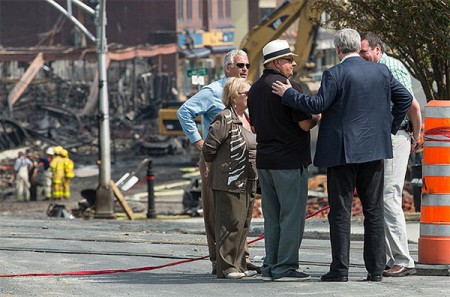Lac-Mégantic: tragic and complicated

Prime Minister Stephen Harper talking with residents of Lac-Megantic on July 7. Photo: Office of the Prime Minister, Creative Commons, some rights reserved
Updating yesterday’s post on the tragic derailment and fire at Lac-Mégantic, Quebec, according to the Montreal Gazette, provincial officials say oil containment efforts are going very well and there is little risk of contamination reaching the St. Lawrence River. Environment Minister Yves-François Blancet told reporters:
“The source has been plugged, practically nothing is getting into the river.”
Physical clean-up will be more complex, requiring decontamination (or removal?) of soil contaminated by the spill and the fire.
And the emotional recovery? Well, that’s barely begun. Consider this: the death toll as of this writing still stands at 15 but the number of persons considered missing has risen to 60. This remains a landscape of prolonged pain for the people of Lac-Mégantic.
The story has several main elements: the tragedy and its impact on Lac-Mégantic, the cause of the event, the implications it raises for moving oil by rail and the safety issues faced by any community where dangerous rail cargo regularly rocks past homes and businesses. In New York’s North Country towns, the sound and sight of a cargo train passing by an everyday thing, and this tragedy raises questions about how we should be thinking about those trains.
Turning to the cause of the “event” – what had initially looked like an accident is now the subject of a criminal investigation. As reported by CBC:
Police said they are investigating whether Saturday’s derailment and subsequent explosion — which leveled the centre of the lakeside Quebec town killing at least 15 and probably dozens more — involved foul play or criminal negligence.
“We are conducting a criminal investigation. We are not neglecting anything so far,” provincial police inspector Michel Forget told reporters on Tuesday evening.
Press reports say this could be North America’s worst rail disaster since 1989. (Those interested in deeper details or current developments would do well to check Canadian news accounts on line.)
NCPR’s Brian Mann has long experience reporting on oil spills and environmental issues. He’s heading to Lac-Mégantic today to cover the situation for NCPR and NPR.
Brian will check in with Martha Foley on tomorrow’s 8 O’clock Hour and may have photos or videos to share on line. Stay tuned.
Tags: energy, environment, Lac-Mégantic, oil, rail safety, train derailment








I realize that in the aftermath of this terrible Lac Megantic tragedy there will be a heightened concern whenever one sees a tank car train moving through their community. However, oil and other hazardous chemicals have been shipped by rail for years with an overall safety record similar to pipelines and barges. The circumstances surrounding the cause of this tragedy are very complicated and we’ll await the results of the investigation. Similarly, the circumstances surrounding the cause of the recent Boeing 777 crash in San Francisco are complicated, but that doesn’t mean that every Boeing 777 is likely to crash on landing.
Good point. Still, with such tragic results possible, its a bit hard to understand why some positive locking parking brake arrangement isn’t standard equipment on these trains.
Or maybe it is, and it was somehow circumvented? I guess we’ll find out in time.
I agree with Tony Goodwin’s comment that moving hazardous material by rail is nothing new. And it is also premature to make assumptions about the cause of this particular derailment.
But there’s been a marked increase in the amount/frequency of dangerous material being moved by rail, which means it’s not the same level of risk.
I love trains and wish North America would make restoring rail systems a higher priority. Instead, far too many rail lines seem to be old and neglected – even as a mini oil boom is throwing more and more tanker cars on the tracks.
Here’s an article from the Ottawa Citizen on 7/10/13 about that issue.
———–
Quoting to further the point:
“According to Statistics Canada, 12,989 rail cars were loaded with more than 1.1 million tonnes of crude in February and shipped off to various locations across Canada and the United States, a 60-per-cent increase over February 2012.
As much as 71,932 tonnes of crude arrived by train at Ontario refineries in 2011, the latest year for which Statistics Canada figures are available — a huge jump over the 9,734 tonnes that arrived by train in 2010.”
————-
To revisit Goodwin’s (perfectly reasonable) example, if San Francisco’s main airport saw twenty Boeing 777s take off and land on any given day, that would be one thing.
But if the same airport ramped 777 traffic up to one hundred, two hundred – maximun 24-hour capacity of such plane traffic – well, that would reasonably produce different results in terms of wear-and-tear, safety and serious incidents.
That ‘s how this becomes an issue for all the towns with rail cargo. It strikes me as something that needs closer attention!